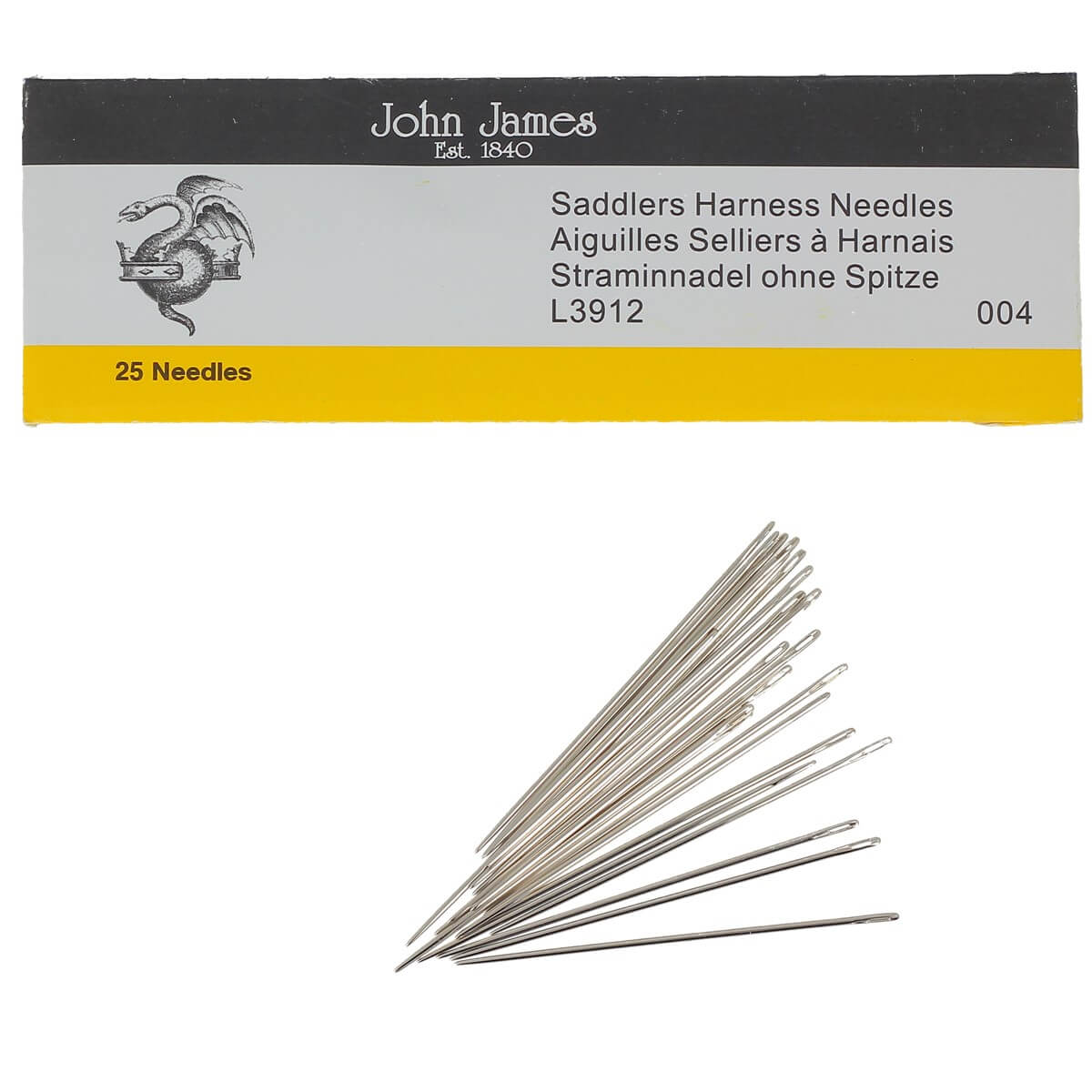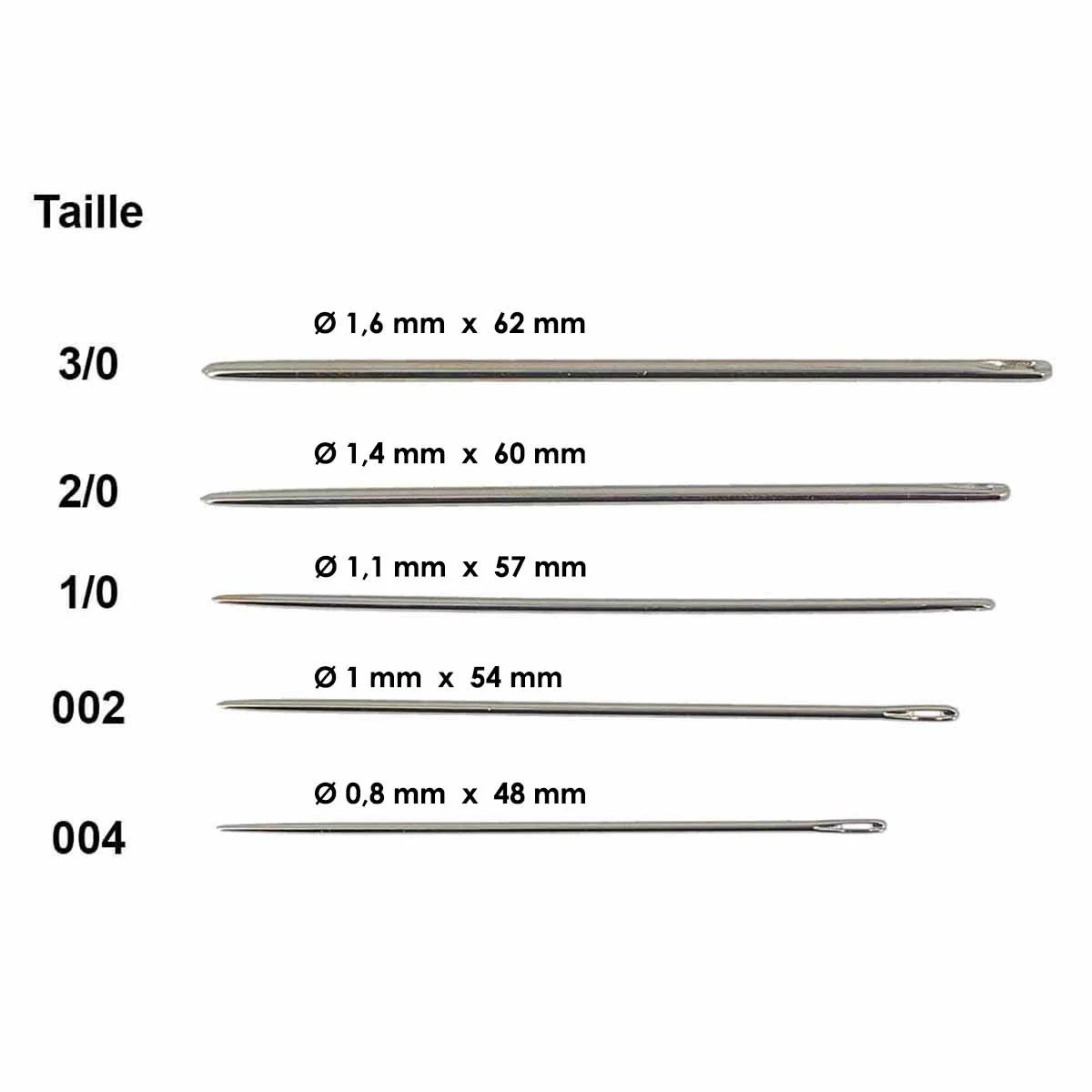WHICH THREAD TO CHOOSE FOR SEWING LEATHER?
We would like to point out that all this data is provided for information purposes only and that there are no “right answers”: everyone must form their own experience.
The larger your item, the more spaced the stitches and the thicker the thread. Commonly, the thread diameter most used for hand sewing leather (saddle stitch sewing) is:
- For leather goods (handbag, satchel, etc.):
le 632 – Fil Au Chinois / M50 – MeiSi – Wire diameter 0.55 mm
or 432 – Fil Au Chinois / M60 – MeiSi – Wire diameter 0.65 mm - For small leather goods (card holders, purses, etc.):
le 832 – Fil Au Chinois / M40 – MeiSi – Wire diameter 0.45 mm
or 632 – Fil Au Chinois / M50 – MeiSi – Wire diameter 0.55 mm
The table below shows you the (approximate) wire equivalences:
| Wire diameter | MeiSi | Fil Au Chinois (Linen thread) |
Fil Au Chinois (Spec. Leather goods) |
Coats Barbour (Linen thread) |
Polyester thread (SERAFIL type) |
Polyamide yarn braided and waxed |
| 0.29mm | No. 60 | |||||
| 0.35 to 0.38 mm | M30 | 28/2 | No. 40 | |||
| 0.41 to 0.45mm | M40 | 832 | 28/3 | No. 30 | ||
| 0.50 to 0.52 mm | 632 | 28/4 | 18/2 | No. 20 | ||
| 0.55 to 0.58 mm | M50 | 532 | 25/3 | No. 16 | ||
| 0.60 to 0.65 mm | M60 | 432 | 18/3 | |||
| 0.69 to 0.70 mm | 18/4 | |||||
| 0.75 to 0.80 mm | M70 | 332 | 18/5 | No. 8 | X | |
| 0.90 to 1.2mm | M90 | 18/7 | X |
WHICH THREAD AND NEEDLE TO CHOOSE FOR SEWING WITH A SEWING MACHINE?
WHICH NEEDLE TO SEW LEATHER BY MACHINE?
When sewing leather with a sewing machine, we recommend using special leather machine needles. These needles, very rigid, are made of hardened steel to avoid breakage when sewing large thicknesses.
WHICH NEEDLE TO CHOOSE FOR HAND SEWING LEATHER?
The round tip needle is the “standard” needle for sewing thick leathers and in particular for saddle stitch sewing. The tip is round so as not to prick your fingers or scratch the leather when sewing. The tip does not need to be pointed because the leather is previously pierced with an awl with pliers (diamond awl). To find out more about saddle stitch sewing, we invite you to see our article:
The pointed needle is used to sew fine leathers: it allows you to pierce the leather directly. You should prefer a needle with a round tip to avoid damaging the leather during sewing.

WHICH NEEDLE TO CHOOSE BASED ON THE THREAD DIAMETER?
Below is a summary table of the compatibility between our round-tipped needles for leather sewing and the different thread diameters .
| Needles | M30 28/2 |
M40 832 28/3 |
632 28/4 18/2 |
M50 532 25/3 |
M60 432 18/3 |
18/4 BRAIDED POLY WIRE |
M70 332 18/5 |
M90 18/7 & BRAIDED POLY WIRE |
| Ø 0.36 mm | Ø 0.43 mm | Ø 0.51 mm | Ø 0.57 mm | Ø 0.63 mm | Ø 0.70 mm | Ø 0.78 mm | Ø1mm | |
| Size 004 – 953 n°05 Ø 0.8 mm - Lg = 48 mm |
++ | ++ | + | - | - | - | - | - |
| 953 n°03 Ø 0.9 mm - Lg ≈ 54 mm |
++ | ++ | + | - | - | - | - | - |
| Size 002 – 953 n°02 Ø 1.0 mm - Lg ≈ 55 mm |
+ | + | ++ | ++ | + | - | - | - |
| Size 1/0 Ø 1.1 mm - Lg = 57 mm |
+ | + | + | ++ | ++ | + | - | - |
| 953 n°01 Ø 1.1 mm - Lg = 60 mm |
- | + | + | ++ | ++ | + | - | - |
| 952-2/0 Ø 1.3 mm - Lg = 70 mm |
- | - | + | + | ++ | ++ | + | - |
| Size 2/0 Ø 1.4 mm - Lg = 60 mm |
- | - | - | - | ++ | ++ | - | - |
| Size 3/0 Ø 1.6 mm - Lg = 62 mm |
- | - | - | + | + | ++ | + | + |
| 953 n°4/0 Ø 1.4 mm - Lg = 80 mm |
- | - | - | + | ++ | ++ | + | - |
++ Fits perfectly + Fits - Not suitable
The Deco Cuir reference needle (L3912) is size 002 / 953 n°2: ⌀1 mm (internal reference: CA118_010 or CA123_010) . You can use this needle for all your “standard” leather goods creations.
For fine stitches and in particular for the creation of small leather goods we recommend the needle size 004 / 953 n°05: ⌀0.8 mm (internal reference: CA118_008 or CA123_008) that is to say for the diameters of wire between 0.36 mm and 0.51 mm.
JOHN JAMES BRAND NEEDLES

WHAT SPACE AND WIRE TO CHOOSE BASED ON YOUR CREATION?
The center distance (distance between the center of 2 teeth) is between 2.25 mm and 6.75 mm, thus meeting different needs. The higher the claw number, the smaller the center distance, so the stitches will be tighter. The center distance must be chosen according to the item you wish to create. The different center distance / wire diameter combinations give different aesthetic results: the choice is yours!

| Leather item | Total leather thickness | Center distance | Wire diameter |
| Small item (e.g. binding, small leather goods) | Max. 2.5mm | 2.5 to 3.38mm | 0.30 to 0.53 mm |
| Medium item (e.g. leather goods) | Max. 4mm | 3.38 to 3.85mm | 0.54 to 0.70 mm |
| Large item (e.g. furniture, saddlery, luggage) | Max. 7mm | 4 to 6.75mm | 0.76 to 1.30 mm |
This table is given for information purposes only, we invite you to look at the images below to form your own opinion. The "standard" for leather goods creations is the center distance 3.38 mm - n°8 (3 points per centimeter).
You will be able to see the rendering of 4 thread diameters on 5 different stitch widths (2.7 - 3.0 - 3.38 - 3.85 and 4.5 mm).
- M30: Ø 0.35 mm
- M40 - 832: Ø 0.45 mm
- M50 - 532: Ø 0.55 mm
- M60 - 432: Ø 0.65 mm






WHAT THREAD MATERIAL FOR WHAT TYPE OF LEATHER DESIGN?
For sewing leather, 2 families of threads are mainly used: polyester thread (synthetic) or linen thread.

Traditionally , linen thread is used to make leather goods: a 100% natural thread. Linen thread is ideal for hand sewing leather. You should know that throughout the life of your leather item the thread will wear out (mainly due to friction): unlike synthetic thread which will cut the leather, linen will tear. It will therefore be easier to sew the leather piece back together than to repair a cut.
For saddlery and harness we advise you to use poached linen thread: the pitch strengthens and waterproofs the thread, making it resistant to the attacks of time and humidity. You can also choose waxed braided polyester thread, knowing that polyester thread is a rot-proof thread.
Polyester thread is widely used for sewing leather with a sewing machine.
WAXED, POUCHED OR GLAZED THREAD WHAT’S THE DIFFERENCE?
Waxed thread: The fibers of the thread have been glued together with beeswax. The wax makes the thread easier to slide when sewing, prevents the thread from knotting and protects the thread during sewing and throughout the life of your creations. Before each seam, we advise you to wax your linen thread using a bar of beeswax. Do not hesitate to cut your wax bar in 2 so that it remains "clean" for working with hot slices.
Poached thread: Pitch is a sticky material obtained by the distillation of pine resin derivatives. There is also synthetic pitch. As indicated a little above, the pitch strengthens and waterproofs the thread, making it resistant to the attacks of time and humidity (perfect for saddlery, saddlery or harnessing). The thread is rot-proof.
Glazed yarn: during its manufacture, the yarn is passed through a starch bath to which beeswax has been added. This technique helps protect the thread during sewing.
TWISTED, CABLED, CARDED OR BRAIDED WIRE WHAT’S THE DIFFERENCE?
 |
 |
|
Twisted yarn: |
Cable wire: |
 |
 |
|
Carded yarn: |
Braided wire: |
















7 comments
Nadine sereng
bonjour, je trouve vos conseils très utiles ……je reviens vers vous très vite pour une nouvelle commande, après avoir fais le point sur le matériel qui me sera nécessaire…merci
M.GECKO
Bonjour,
C’est un vrai plaisir de parcourir ce site qui me rappelle plein de bon souvenirs étant fils de bourrelier et ayant travaillé quelques temps ce beau matériau avec de vieux outils qui sont aujourd’hui remis au goût du jour avec une qualité remarquable.
Je suis passé au magasin pour acheter une peau et réaliser 2 tabliers pour faire des cadeaux….
Je viens de réaliser une pince à coudre sur table (en merisier de récupération ) en plus de ma vieille pince et je compte bien refaire des articles de cuir avec plaisir.
Bravo déco cuir !
Michel
isabelle Michaud-Soret
Merci, ces informations sont très intéressantes pour s’y retrouver dan sle choix des fils, des entraxes et des aiguilles
Jacob.c
Bonjour
Merci pour toutes les informations pratiques.
Je me renseigne avant de me lancer.🤞
Anonymous
Je vous trouve géniaux, merci pour toutes vos informations très utiles,
j’ai créée des tabliers en cuir et je suis fan de votre site!!!
Anonymous
Merci beaucoup ! J’ai appris des trucs !
On arrête pas d’apprendre en fait !
Anonymous
Merci beaucoup pour toutes ces informations, très précieuses pour l’absolue néophyte que je suis !